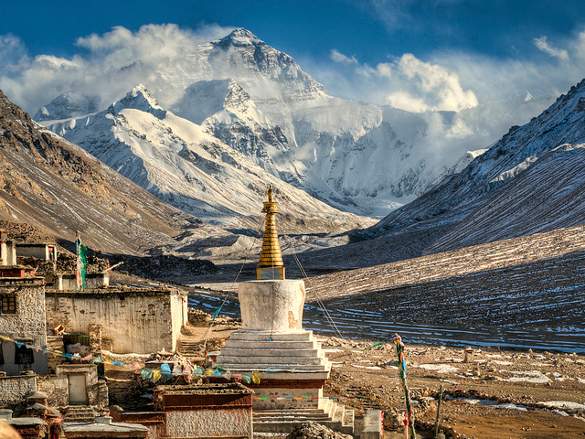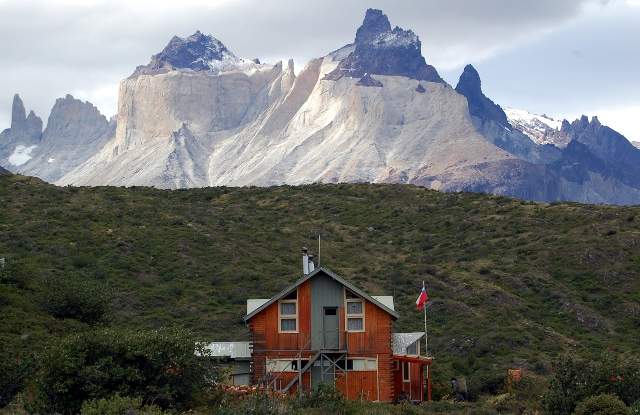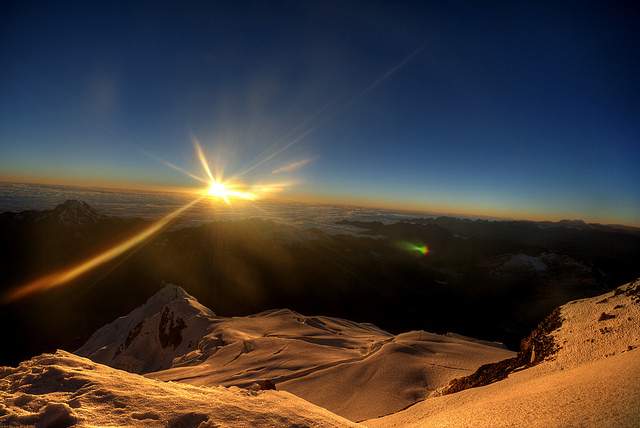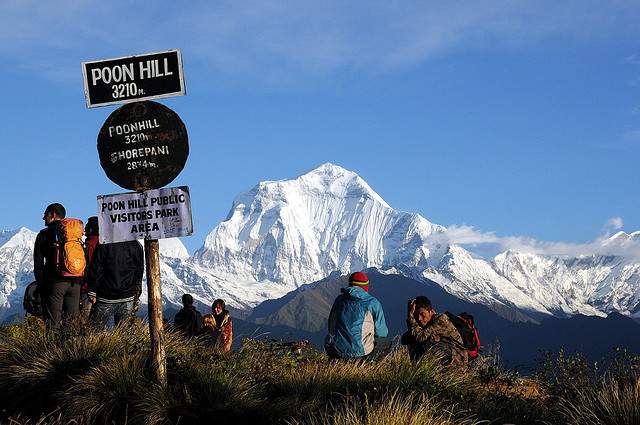Part of what we love about indie travel is doing the abnormal – getting outside the box of the typical one or two week vacation. In today’s article, we break down a trip for the adventurous – the active traveleler, the hiker. Trek Around the World highlights a trip with a hiking theme, so if you love the outdoors and trekking, check out this trip through Peru, Argentina, Bolivia, Chile, Tanzania, and Nepal.
Route
Denver > Lima, Peru > overland through South America (hiking Machu Picchu, Bolivia, Patagonia – both Argentina and Chile) to El Calafate, Argentina > Buenos Aires, Argentina > Dar Es Salaam, Tanzania > Kathmandu, Nepal > Denver.
Notes
- The dates we searched for this trip were November 2, 2013 – March 25, 2014. We planned this trip with optimal hiking seasons in mind for all locations. It’s difficult to find the best times to hit all these locations on one trip, but we managed to get in during the high season or shoulder season at worst.
- Prices can and will vary depending on a variety of factors, including your point of origin, travel dates and when you actually book.
[social]
Why you should take this trip
Pros
- If you’re a lover of the outdoors and want to incorporate plenty of hiking and trekking into your trip, then this is the one for you.
- You will get to hike in some of the most amazing places on Earth.
- Machu Picchu – using the classic Inca Trail or any number of alternative treks
- Andes of Bolivia – the options are limitless for really getting off-the-beaten path
- In and around Patagonia in both Chile and Argentina
- El Chalten, Argentina offers a multitude of opportunities.
- Torres del Paine in Chile is one of the most sought after trekking destinations in the world.
- Kilimanjaro – Africa’s tallest mountain and one of the most walkable in the world – meaning you won’t need any climbing gear.
- Nepal – possibly the hiking mecca of the world. There’s Annapurna, and of course this other little mountain named Everest.
- One of the most appealing parts of this route is that any hiking lover can hike in all of these areas – from the novice (it helps to be in some decent shape) to the hardcore.
- There is more to this route than hiking (if that’s what you want). Big, bustling cosmopolitan cities can be hit on this trip, too, in addition to African safaris if wildlife interests you.
Want to plan your own RTW trip? Sign up today for Plan Your RTW Trip in 30 Days and start receiving email lesson plans tomorrow – it’s free!![]()
Cons
- South America is a huge continent, and while we allowed plenty of time in our proposed route to get from Lima to El Calafate by land, hitting all necessary destinations, it will be slow going. If you are short on time, you’ll most likely have to sprinkle a few flights in while in South America.
Unique to this route
Machu Picchu. Patagonia. Kilimanjaro. Everest. On one trip. If that doesn’t get your outdoorsy juices flowing, then I don’t know what will. Add in the fact that, if you want, you can do this on a tight budget (outside the flights, of course), camping your way around most locations, and this can be a great trip for the outdoor-loving backpacker.
One of the most appealing parts of this route is that any hiking lover can hike in all of these areas – from the novice to the hardcore.
Check out the following articles for these regions:
- Machu Picchu and Kilimanjaro: 2 Adventures You Can’t Do Yourself
- Hiking the Inca Trail to Machu Picchu: An Experience Like No Other
- Everest: Need I Say More?
- Climbing Africa’s Highest Peak – Mount Kilimanjaro
This Route Appeals To
- Any traveler who is active and has a love for the outdoors.
- Budget-minded backpackers who don’t mind lugging a tent around the world.
- Those with a bit higher budget can also do this trip without bringing their own camping gear. All necessary gear is available for rent in all areas, and there are some hikes you can do while staying indoors (like Torres del Paine).
- Solo travelers will have an easy time meeting up with other like-minded folks on the trails or in the tour groups where tour groups are necessary (Kilimanjaro and the Classic Inca Trail).
- Couples who have a love for the outdoors will eat this trip up. Get toned and in amazing shape for each other by hiking around the world.
RTW Context
If you plan on using a similar itinerary for your RTW trekking trip, then you’ll probably need at least 3-4 months, and that would be pushing it, especially if you used overland transportation throughout most of South America like we suggest. A few flights here and there (from Bolivia down to Patagonia, then Patagonia back up to Buenos Aires), would save you significant time.
The way we have it mapped out would have travelers taking about 5 months to complete. Of course, you could take longer, but you will have to keep an eye on weather. Many of these locations become nearly impossible to get to in wet weather. See the weather section below for more in-depth information.
Practical Information
When to Go/Weather Information
Weather is always going to be the challenging part of planning a long-term trip, particularly when you plan on spending the majority of it outside hiking and camping. Balancing best times to go can become a headache. Here is how we have it mapped out and why:
- Start in Peru in November. This is the very start of rainy season, so there will be a risk, but we personally traveled in Peru and Bolivia in November and December, and we had few issues (obviously it can and does vary from year to year).
- Make your way through Peru and Bolivia and down into Argentina, heading south to Patagonia, with the goal to arrive around mid December, depending on how much you want to do in the previous two countries.
- A month to a month and a half would be perfect to set aside for Patagonia, giving you plenty of opportunities for exploring the region in depth. December to February is the best time to visit Patagonia, weather-wise (although this also means larger crowds and higher prices).
- Make your way back up to Buenos Aires by mid-late January to catch a flight to Dar Es Salaam.
- The optimal times for hiking Kilimanjaro is mid June – September and December – January. You’ll be doing it at the end of one of the high seasons and into shoulder season with this itinerary. Weather should be good.
- Back to Dar Es Salaam to catch a flight to Kathmandu in late February.
- High season for hiking Everest Basecamp is March to mid-May and September – mid-November, so with this itinerary, you’ll be arriving just before high season begins.
- If you want to hike Annapurna, this is a good (but not great) time to do so. Crowds will be thinner and weather warmer, but there is a higher chance of fog, possibly obscuring views of the Himalayas you came so far to see.
Keep in mind that when you are considering weather for a trip like this that you will be in the mountains. Even if you go during the optimal season, weather can and will change at the drop of a hat, particularly at elevation, so don’t expect perfect conditions. The mountains are a fickle bitch when it comes to weather.
To read more in-depth information about weather in these regions, check out the following links:
Which direction to go
For this trip, which direction to go depends on a couple factors – the weather and flight prices. Weather is the big one when planning an outdoor-heavy trip such as this, and while we have figured out a good route (see weather section above), you may be able to work out other possibilities. If you decide to go the opposite direction (staring in Nepal then working your way back to Kili, then on to South America), be sure to check flight prices. Even though you’re going to the same destinations, flights prices can vary wildly.
Even if you go during the “optimal” season, weather can and will change at the drop of a hat in the mountains, so don’t expect perfect conditions.
Time zones
Denver GMT -6; Lima/Cusco GMT -5; El Chalten, Argentina GMT -3; Torres del Paine, Chile; GMT -4; Buenos Aires, Argentina GMT -3; Kilimanjaro, Africa GMT +3; Kathmandu, Nepal GMT +5:45
Shots and visas
Consult your local embassy or consulate for visa information.
You may need shots depending on a variety of factors, including your immunization history, your medical history, and which countries you plan on visiting in what order. Consult the CDC website and your doctor for vaccination information.
Learn more about travel immunizations and common types of visas
Packing
Layers, layers, and more layers. While outdoor, travel-specific clothing is expensive, it’s so nice to have when you’re in the outdoors as much as you will be for this trip. You are going to want lightweight, moisture-wicking clothes. And layers. Did I mention layers? Here is what I would suggest bringing on a trip like this (these work for both men and women):
- A few short-sleeve tees (no cotton!)
- A few long-sleeve tees (no cotton!)
- A quarter or half-zip thermal type shirt (lightweight)
- A microfleece
- A nice, waterproof rain jacket is a must when you’re in the mountains.
- If you follow the schedule we outlined, you most likely won’t need a heavy, winter coat. You may have to splurge for one in Nepal if you plan on hiking to Everest Basecamp, but it won’t be necessary if you’re only hiking Annapurna.
- A warm hat and gloves are a must, too.
- For pants, some type of synthetic, nylon/polyester blend is best. They’re lightweight and dry super quick. And while they may look really dorky, the zip-off convertible pants are great to have when hiking.
- For socks, again if you splurge on nice socks, you will thank yourself later. There’s nothing worse than blisters on the trail. Some type of sock made of merino wool is what you should be looking for.
- Shoes/boots: Everyone is different when it comes to shoes/boots, but like socks, this isn’t something you want to skimp on. There’s a reason some hiking shoes/boots cost $50 and others cost $150. Personally, I don’t like boots; I’ve hiked the Inca Trail, all around Patagonia, and in the Indian Himalayas with just a good pair of hiking shoes. If you have weak ankles or a history of ankle injuries, though, boots are definitely the way to go.
- Fellas, don’t skimp on the underwear. Swamp ass is no fun when on the trail for multiple days, so do yourself a favor and buy some Ex Officio underwear. Yes, I know they’re $25 apiece, but I brought 4 pairs of these (the only 4 pair I brought) for my RTW trip back in 2008-2009, and I had them until 2011. So they are worth it, I swear.
- When it comes to underwear for the ladies, Ex Officio makes some for you as well. My wife wears the same underwear for hiking that she does everyday, but I would imagine it’s all personal preference.
- Also for the ladies, a few sports bras are essential – synthetic, wicking material is best.
To read more about packing, check out these articles:
Trip notes
5 amazing hikes in South America
- Machu Picchu (Peru) – This is a must, and if you’re looking to stay away from crowds and not spend a lot of money, then look into alternative treks that aren’t the Classic Inca Trail. Salkantay and Lares are the two most popular alternative treks.
- Condoriri to Huayna Potosi (Bolivia) – If you’re looking to get off-the-beaten-path, then Bolivia is where you want to be. This particular trek passes through the Condoriri group, with 13 peaks higher than 16,000 feet (5100m).
- Choro Trek (Bolivia) – This hike is mostly downhill, starting at 15,750 feet (4800 meters) and descending to about 5000 feet (1500 meters). But don’t let this description fool you. This trek is anything but easy, and it can be a killer on your knees. It has stunning views and ends in the very cool little town of Coroico.
- El Chalten, Argentina (Patagonia) – This trekker’s paradise provides a bounty of options. You can take your tent and climbing gear and head out for a week of some hardcore trekking and climbing, or you can do 8-12 hour day hikes and still sleep in a bed and eat in a restaurant in town.
- Torres del Paine (Chile) – Hikers and trekkers from around the world come to Torres del Paine for some of the best hiking on Earth. Hike the classic W trail or go for the full circuit if you’re up for some backcountry experiences.
For more on travel in South America, check out our one-page Indie Travel Guides:
- Peru Indie Travel Guide
- Cusco Indie Travel Guide
- Arequipa Indie Travel Guide
- Bolivia Indie Travel Guide
- Argentina Indie Travel Guide
- Buenos Aires Indie Travel Guide
- Chile Indie Travel Guide
- Patagonia Indie Travel Guide
On the cheap
Peru and Bolivia are great places for budget travelers, and if you plan on bringing your own tent and camping, it gets even cheaper. The Classic Inca Trail costs upwards of $500USD to hike, so check out alternative treks which are much cheaper (and far less crowded). Backpackers can plan to budget about $10-15USD for a dorm bed in Peru and closer to $5-7 in Bolivia. Most hostels have kitchens, so cooking is possible. A hiking trip such as this will save you money if you go at it on your own (particularly in Bolivia), but even hiring a guide or going with a group won’t cost much.
Patagonia is a whole different story, particularly in high season (December – February). All prices go up, so having your own tent and sleeping bag will save you loads as you’ll still be able to hit up grocery stores and cook for yourself. On a barebones budget, meaning you camp most of the time and cook most of your meals, expect to spend about $20-25USD/day. A hostel bed can cost that much alone during high season.
Hikers and trekkers from around the world come to Torres del Paine for some of the best hiking on Earth.
Torres del Paine is even more expensive than the rest of Patagonia. Again, having your own gear will save you loads of money. Even with that and cooking your own food, you have transportation costs for getting there and back from the nearest town (Puerto Natales), which costs about $35USD round trip. Tickets to get in the park cost about $35USD as well. Depending on which direction you hike, you’ll have to take a catamaran ($25 one-way; $40 round-trip). If you camp at a refugio (lodge) site, the cost is about $8 for the campsite (more if you have to rent a tent and sleeping bag/mat). Food at refugios is also pricey, ranging from $12 for breakfast, $15 for lunch, and $20 for dinner.
Mid-Range Budget
If you don’t want to camp much outside of the actual hiking part of your excursion and want to stay in a private room with bathroom at a hostel, expect to pay about $20-25 in Peru and $12-20 in Bolivia. In Patagonia, those costs climb closer to $40 and $50 (during high season).
When hiking Torres del Paine, you can rent a tent, sleeping bag, and sleeping mat from the refugios inside the park, eliminating the need to carry them yourself (they will set up your tent for you before your arrival). Costs are about $15 for a tent (for two), $3 for a sleeping pad, and $10 for a sleeping bag.
Alternatively, if you don’t mind carrying extra weight, you can rent gear in Puerto Natales before leaving. Expect to pay about $7 for a tent, $7 for a sleeping bag, $4 for a stove, and $9 for a mess kit. If you want to stay inside the refugios and not mess with camping or carrying all that crap, then prices range from $40-$60/person for a bed in a dorm.
To read more about traveling and hiking in South America, check out the following articles and resources:
- Check out hostels in South America
- Browse our adventure trips in South America
- Read How to Plan an Extended Trip in South America
- Read Tips for Visiting the Salar de Uyuni in Bolivia
- Read the Step-by-Step Guide to Visiting Machu Picchu
- Read Five Unexpected Treasures of South America
5 places to explore in Tanzania that aren’t Mount Kilimanjaro
- Ngorongoro Conservation Area – This area is basically an old volcano that collapsed, forming a crater and becoming a haven for wildlife. The crater has the highest density of lions on Earth. You may also see zebras, gazelles, wildebeest, buffalo, and possibly a black rhino.
- Serengeti National Park – One of the most popular places on the continent to go on safari. If you make it to Serengeti during the right time of year, you will be able to see the spectacular migration of over a million animals.
- Ruaha National Park – Not as popular or with as much wildlife as other options, but Ruaha will have far fewer tourists if that is more your style.
- Zanzibar – Tanzania is not all hiking and wildlife viewing. Zanzibar has some amazing beaches and is a great place to go scuba diving and/or snorkeling.
- Mafia Island Marine Park – Another fantastic place for underwater activities, and this is one of the only places in the world where whale sharks congregate annually.
Kilimanjaro Budget
Hiking Kilimanjaro can be as cheap or expensive as you’d like. You have plenty of options when hiking Kili, but one option you don’t have is going at it independently. You have to hire a guide or go with a tour group of sorts (which is why the options are many).
On the Cheap
If you’re wanting to hike Kili on the cheap, set aside about $800USD for the cheapest option. That cost seems high, but that’s all inclusive, meaning once you’re on the mountain, you won’t have to pay for anything besides chocolate bars and beer (if you want, of course). Outside of Kili, it’s not difficult to get by on $5-10 night for a bed and street food meals for under a dollar.
Mid-Range Budget
While the cheapest options starts at just under $1000USD for a trek to the top of Kilimanjaro, prices can soar over $5000 for those with the cash to do it. That means there are also prices everywhere in between. Obviously quality varies drastically, and it pays to do your homework when trekking in a developing country such as Tanzania. Expect to pay closer to $1500USD for anything more than a bare-bones trip to Kili.
Check out our one-page Indie Travel Guides for Tanzania:
- Tanzania Indie Travel Guide
- Zanzibar Indie Travel Guide
- Dar es Salaam Indie Travel Guide
- Kilimanjaro Indie Travel Guide
5 reasons to hike Annapurna in Nepal
- Big mountains – The largest peak in the Annapurna region is 26,500 feet (8000 meters). To give you some perspective, the highest peak in the United States’ Rocky Mountains is 14,400 feet (4400 meters).
- Access – While the Everest region is more brag-worthy, Annapurna is much more accessible for those who aren’t super-hardcore trekkers but have dreamed of hiking in the Himalayas.
- Variety – Did you know that when you hike the Annapurna Circuit, it begins in a jungle before moving on to canyons, then forests with pines, then finally the Himalayas? Yeah, most people don’t.
- History – Annapurna is unique in that you aren’t out in the wilderness all alone. You hike from town to town, village to village, along an ancient trade route that is still used today.
- Teahouses – You can take as much or as little time to hike Annapurna as you’d like, mainly because of the teahouses that dot the trail. They are usually no more than 3 hours apart from each other and only charge a nominal fee (typically under $15US) for accommodations and meals. This means no need for a massive pack as it’s unnecessary to carry much food or a tent.
Nepal Budget
On the Cheap
If you want to hike Annapurna and do it on the cheap, it can be done for close to $10USD per day, and that’s staying at teahouses along the way and doing the trek independently. It is a remarkably cheap trek, and you also get the chance to sleep indoors, take showers, and eat hot meals daily – quite a bit different than most other treks around the world.
The largest peak in the Annapurna region is 26,500 feet (8000 meters). To give you some perspective, the highest peak in the United States’ Rocky Mountains is 14,400 feet (4400 meters).
If you’re looking to hike to Everest Basecamp, it can be done on a cheaper budget, but nothing compared to Annapurna. Plan on spending at least $25USD per day on accommodations and food. The higher you get, the more expensive things become.
Mid-Range Budget
If you want to visit Annapurna but maybe stay in nicer hotels as opposed to teahouses, it can still be done on a budget of about $15-20 per day. If you’re looking to catch a ride here and there instead of hiking the entire trail, or if you want to take an organized trek, then budget closer to $40-50 per day.
When it comes to hiking in the Everest region, here’s a basic rundown of costs:
- $4-10/day for a basic room
- $5-10/day for meals
- $2-4 for a hot shower
- $1.50-5 for bottled water (the higher up you go, the more it costs)
- $15-20/day for a porter
- $30-50/day for a guide
Have you visited any of these regions as part of a longer trip? Do you hope to? Comment below to share your stories or tell us what you’re looking forward to.
Photo credits: Goran, timsnell, mattk1979, Nomad Tales, all others courtesy of the author and may not be used without permission.





